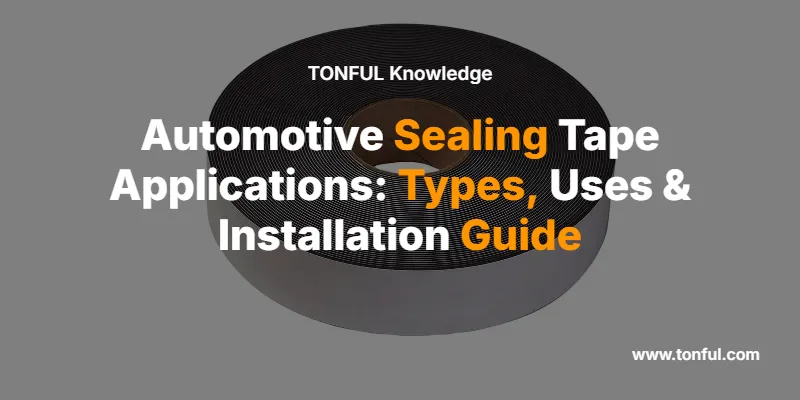Introduction
Automotive sealing tapes have evolved from simple gasket materials into sophisticated engineered solutions that solve some of the industry’s toughest challenges. Every vehicle rolling off the assembly line today depends on these pressure-sensitive materials to keep water out of door cavities, quiet wind noise at highway speeds, and bond body panels without adding the weight of mechanical fasteners. In electric vehicles, they’ve taken on new roles—insulating high-voltage battery modules and managing heat around cells that can’t afford to fail.
Unlike the electrical tapes familiar to most technicians, automotive sealing tapes combine compressible foam or elastomer cores with adhesive chemistries tailored for surfaces ranging from bare aluminum to textured plastics. They’re specified to survive temperature swings from Arctic cold starts to under-hood heat, UV exposure that would degrade lesser materials in months, and years of flexing as doors open and panels vibrate. OEMs validate them through standardized tests—peel adhesion, dynamic shear, compression set—that tie directly to warranty claims and customer satisfaction scores.
This guide walks through the types of sealing tapes used across body assembly, paint shops, trim attachment, HVAC systems, and battery packs, the performance benchmarks they must meet, and how to choose the right tape for specific applications. Whether you’re bonding side moldings, sealing a sunroof, or assembling an EV battery module, understanding these materials means fewer callbacks and better results.
Types of Automotive Sealing Tapes
Acrylic Foam Tapes
Acrylic foam tapes are the workhorses of structural bonding in automotive assembly. Built around a viscoelastic foam core laminated between high-performance acrylic adhesives, they replace spot welds and mechanical fasteners by distributing stress across the entire bond area. The foam core absorbs energy from vibration and thermal expansion, while the acrylic adhesive delivers aggressive initial tack and long-term durability against heat, UV, moisture, and solvents.
These tapes bond to an unusually wide range of substrates—painted steel, bare aluminum, powder-coated panels, glass, and both high- and low-surface-energy (LSE) plastics. Specialized families are engineered for specific challenges: GPH grades survive paint-bake cycles at temperatures up to 450°F, allowing panels to be bonded before they enter the paint booth, while LSE formulations grip polypropylene and TPE trims that conventional adhesives can’t hold. In transportation applications, acrylic foam tapes are the go-to choice for body side moldings, emblems, and exterior trim where appearance, weather sealing, and long-term bond integrity matter.
Polyurethane and Acrylic Foam Bonding Tapes
When intricate die-cut shapes or extra compressibility are required, polyurethane foam tapes step in. They’re softer and more conformable than acrylic foams, making them ideal for nameplates, badges, and small emblems where the tape must follow complex curves and contours. Polyurethane cores deliver excellent tensile and dynamic shear strength, holding up under flexing and impact.
Acrylic foam bonding tapes, on the other hand, emphasize peel adhesion to automotive paint systems through viscoelastic deformation—the foam slowly flows into microscopic surface texture, maximizing contact area. Performance is characterized through ASTM standards: D3330 for peel, D1002 for dynamic shear, and D3654 for long-term static loading. These benchmarks let engineers compare tapes across substrates and aging conditions, ensuring choices align with OEM durability requirements.
PVC Foam Sealing Tapes
PVC foam sealing tapes are the soft, closed-cell gaskets that create positive seals in mechanically fastened joints. With a single-sided pressure-sensitive adhesive, they compress at low force to block dust, water, and air around door locks, side mirrors, instrument panels, and sunroofs. Their closed-cell structure resists water absorption, and they’re formulated to meet FMVSS 302 flammability standards for interior use.
OEM material specifications—such as Chrysler SAY500 Type 7 and GM GMW17408—define acceptable density, Shore hardness, compression set, and peel adhesion ranges. Installation is straightforward: clean the surface with isopropyl alcohol, apply the tape, and compress the joint. Service temperature windows typically run from around -26°C to 71°C, covering most climate zones without losing seal integrity or adhesion.
EPDM and PE Foam Gasket Tapes
Closed-cell EPDM and polyethylene foam tapes bring cushioning, vibration damping, and environmental sealing to battery packs and HVAC assemblies. Available with single- or double-sided adhesives, they form compressible gaskets that seal against dust and humidity while absorbing shock and reducing buzz-squeak-rattle in assemblies where components move or expand.
In electric vehicle battery modules, these foams accommodate cell breathing—the slight expansion and contraction that occurs during charge-discharge cycles. Laminates can integrate flame barriers (UL 94 rated), thermal interface materials, and electrically insulating films, creating multifunctional tapes that address sealing, thermal management, and safety in a single component. The result is faster assembly, lower weight, and fewer potential leak paths than traditional gasket-and-fastener designs.
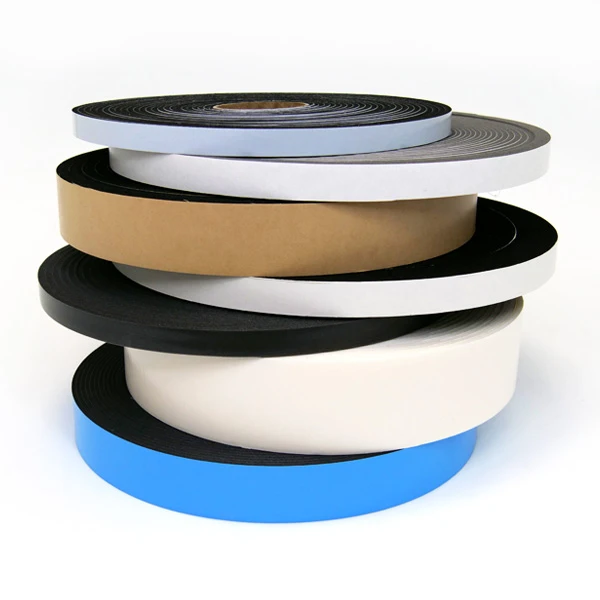
Key Applications in Modern Vehicles
Weatherproofing and Environmental Sealing
Door seals, trunk gaskets, and sunroof perimeters are the front line of defense against water intrusion and wind noise. Compressible foam sealing tapes create positive seals at mechanically fastened joints, blocking rain, dust, and light while maintaining flexibility through thousands of open-close cycles. The closed-cell foam structure resists water absorption, preventing the tape from swelling or losing compression force over time.
Acrylic foam tapes used in transportation applications are engineered for extreme environmental durability—they maintain adhesion and sealing performance through temperature cycling from well below freezing to summer heat soak, resist UV degradation that would crack conventional gaskets in months, and remain stable when exposed to road salt, detergents, and fuel vapors. For technicians working on aftermarket weatherstripping or body panel replacement, choosing tapes with proven outdoor exposure resistance is the difference between a repair that lasts and one that starts leaking within a year.
NVH Reduction (Noise, Vibration, Harshness)
Foam sealing tapes play a critical role in cabin comfort by damping vibrations and blocking sound transmission paths. Placed between body panels, around door frames, and in HVAC assemblies, they absorb high-frequency buzz and prevent metal-to-metal contact that transmits road noise into the passenger compartment.
In electric vehicles, NVH control takes on added importance because there’s no engine noise to mask wind, tire, and drivetrain sounds. Battery pack assemblies use foam spacers and gaskets not just for sealing, but to cushion cells and modules against shock loads and reduce the buzz-squeak-rattle that customers associate with poor build quality. The viscoelastic properties of acrylic and polyurethane foams—how they slowly deform and recover—directly impact how much vibration energy they dissipate versus transmit.
Panel Bonding and Trim Attachment
Acrylic foam tapes have largely replaced mechanical fasteners for attaching body side moldings, emblems, nameplates, and decorative trim. By distributing stress across the bond area rather than concentrating it at fastener points, they reduce the risk of stress cracks in panels and eliminate the need for visible holes or clips. The bond is instant—no curing time—and can be applied in-line during assembly without slowing production.
For body panels themselves, structural acrylic foam tapes bond aluminum and steel components in ambulance bodies, truck caps, and composite body assemblies. Tapes designed for paint-bake cycles (GPH families) allow bonding before the panel enters the oven, streamlining throughput and eliminating the corrosion risk of exposed welds. When engineers spec these tapes, they’re looking for data on peel adhesion after thermal cycling, dynamic shear under vibration, and long-term creep—the slow deformation under constant load that can cause bonds to fail years down the road.
HVAC and Interior Module Sealing
HVAC systems depend on precise seals to direct airflow, prevent condensation leaks, and isolate hot and cold zones. PVC foam sealing tapes compress at low force to conform to irregular mating surfaces around blower housings, evaporator cases, and duct junctions. Their closed-cell structure blocks moisture migration, and FMVSS 302 flammability compliance ensures they meet safety standards for interior components.
Instrument panels, door modules, and center consoles also use foam sealing tapes to eliminate squeaks, cushion hard plastic edges, and seal out dust. Because these components are assembled and disassembled during vehicle production and service, the tape’s peel adhesion must be strong enough to stay in place but forgiving enough not to tear foam or leave residue when removed.
Under-Hood and High-Temperature Environments
Under-hood applications subject sealing tapes to heat from exhaust manifolds, turbochargers, and coolant lines, along with exposure to engine oil, transmission fluid, brake fluid, and fuel vapors. Tapes rated for continuous service above 100°C and short-term excursions to 150°C or higher are necessary to maintain sealing and bonding performance.
Acrylic foam tapes with high-temperature adhesive systems are used to bond heat shields, attach underhood insulation, and seal air intake ducts. The adhesive must remain tacky enough to maintain bond strength at peak temperatures while not softening so much that it flows or leaves residue. Material compatibility testing—exposing tape samples to automotive fluids for extended periods and then measuring retained adhesion—is standard practice for under-hood applications.
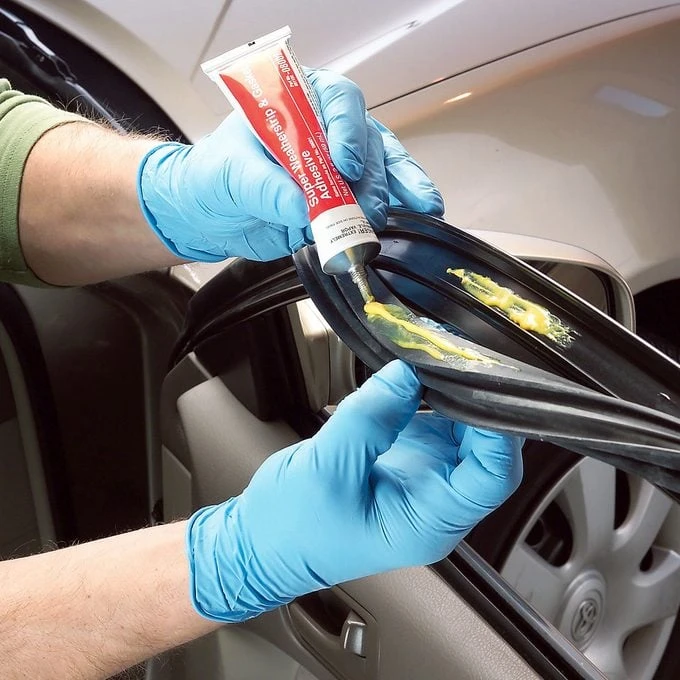
Performance Requirements and Industry Standards
Substrate Adhesion and Compatibility
Automotive assemblies bring together painted steel, bare aluminum, powder-coated castings, polypropylene bumper covers, glass, and thermoplastic elastomers—sometimes all in the same subassembly. A sealing tape that grips one surface may slide off another. Acrylic foam tapes are valued precisely because they bond across this range, but even within that family, formulations matter. Standard grades work well on metals and painted surfaces; LSE (low-surface-energy) grades are required for unpainted plastics like polypropylene and TPO that lack the surface tension for conventional adhesives to wet out.
Surface preparation amplifies or sabotages adhesion. Oils, mold release agents, and dust contaminate bonding surfaces, and a wipe with isopropyl alcohol is the minimum. For critical structural bonds, manufacturers specify abrasion or plasma treatment to increase surface energy and mechanical keying. Testing adhesion on actual production substrates—ideally with the same surface finish and any coatings applied—is the only way to verify a tape will perform as expected.
Temperature and Environmental Resistance
Service temperature windows define where a tape can operate without losing adhesion, becoming brittle, or softening into a gooey mess. Most automotive sealing tapes are specified for continuous service from around -40°C to +80°C, covering Arctic winter starts and summer dashboard heat. Under-hood applications demand continuous ratings above 100°C, with short-term resistance to 120°C or higher near exhaust components.
Acrylic foam tapes designed for paint-bake cycles withstand intermittent exposure to 230°C (450°F) for the time it takes a body panel to cure its paint, then return to normal service temperatures without delaminating or losing bond strength. UV resistance matters for any tape exposed to sunlight—exterior trims, sunroof seals, and convertible top assemblies. Accelerated weathering tests (ASTM G154, G155) simulate years of outdoor exposure in weeks, revealing which tapes will chalk, crack, or lose adhesion under UV and moisture cycling.
Mechanical Performance Testing
Engineers use standardized mechanical tests to compare tapes and predict how they’ll hold up in the field.
Peel adhesion (ASTM D3330) measures the force required to peel tape from a substrate at 90 or 180 degrees. Higher values mean better resistance to being pulled off—important for vertical installations and flexing parts. Dwell time affects results, so datasheets report both immediate and aged peel (24-hour or 7-day conditioning).
Dynamic shear testing (ASTM D1002) applies a pulling force parallel to the bond until it fails. This simulates the loads that try to slide bonded parts past each other during vibration and thermal expansion. Panel bonds and trim attachments live or die by their shear performance.
Static shear and creep resistance (ASTM D3654) hang a weight from a tape sample and track how long it holds before sliding or failing. The test reveals long-term performance under constant load—a heavy emblem on a vertical panel in summer heat, for instance—and flags tapes prone to cold flow.
Compression set and recovery tests (ASTM D3574, D1056) characterize foam behavior: how much it compresses under load, how much springs back when released, and whether it takes a permanent set. For sealing applications, low compression force and high recovery matter most. Some compression loss over time is tolerable as long as the seal holds.
OEM Material Specifications and Regulatory Compliance
Automakers maintain internal material specifications that define acceptable ranges for density, hardness, compression set, flammability, and adhesion. PVC foam sealing tape datasheets cite compliance with specs like Chrysler SAY500 Type 7 and GM GMW17408, signaling that the material has been tested and approved for use in those companies’ vehicles. Meeting these specs isn’t just about performance—it’s about liability, warranty coverage, and the ability to bid on OEM contracts.
FMVSS 302 (Federal Motor Vehicle Safety Standard 302) sets flammability limits for interior materials in vehicles sold in the U.S. Tapes used in passenger compartments must pass a horizontal burn test, demonstrating that they won’t contribute to rapid fire spread in the event of a crash. Similar standards exist in other markets (ECE R118 in Europe, GB 8410 in China), and global suppliers design tapes to meet the most stringent requirements.
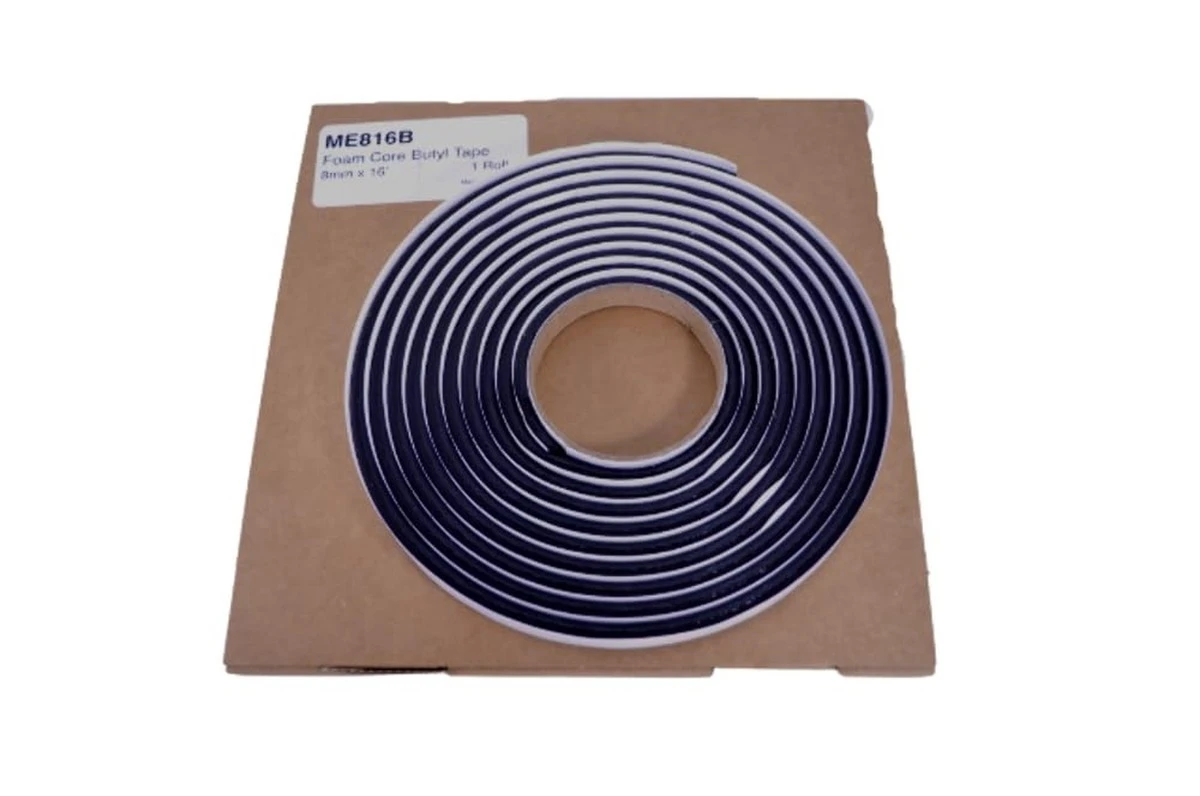
EV-Specific Applications and Emerging Trends
Battery Pack Sealing and Thermal Management
Electric vehicle battery packs are sealed enclosures that must protect lithium-ion cells from moisture, dust, and physical damage while managing heat and allowing for the slight expansion-contraction (breathing) that occurs during charge-discharge cycles. Foam sealing tapes serve multiple functions here: compressible gaskets that seal pack lids and module covers, flame-barrier laminates (UL 94 rated) that slow fire propagation between cells, and thermal interface materials that conduct heat from cells to cooling plates.
Thermal management tapes combine a thermally conductive filler (often ceramic or graphite) with a pressure-sensitive adhesive, delivering thermal conductivity up to 2 W/m·K (ASTM D5470) while eliminating the mess and cure time of thermal greases. These tapes are formulated to be solvent-free, halogen-free, and silicone-free—process compatibility requirements driven by the need to avoid contaminating cleanroom assembly lines and sensitive electronic components.
Electrical Insulation and EMI Shielding
High-voltage battery systems require dielectric insulation to prevent short circuits between busbars, cell terminals, and grounded pack structures. PET film tapes with acrylic adhesives provide high dielectric strength and puncture resistance, wrapping busbars and insulating cell tabs. Electrically conductive foam and fabric tapes, on the other hand, serve EMI shielding and grounding functions—attaching to pack enclosures to bleed off static and shield sensitive control electronics from electromagnetic interference generated by high-current switching.
Lightweighting and Sustainable Materials
Every kilogram removed from a vehicle increases range and efficiency, making lightweight bonding solutions attractive. Replacing mechanical fasteners with thin foam tapes cuts mass, eliminates corrosion-prone steel clips, and speeds assembly. The push extends to materials themselves: manufacturers are developing bio-based adhesive chemistries and recyclable foam cores to reduce the carbon footprint of tape production and support end-of-life vehicle recycling mandates in Europe and China.
Low-VOC (volatile organic compound) acrylic adhesives address air quality regulations in paint shops and final assembly plants. As emission limits tighten and OEMs commit to carbon-neutral manufacturing, tape suppliers are reformulating products to eliminate solvents and reduce curing energy, delivering environmental benefits without sacrificing bond performance.
Installation Best Practices
Surface Preparation
Clean, dry surfaces are non-negotiable for strong, durable bonds. Oils, fingerprints, mold release agents, and dust prevent adhesive from wetting out and bonding at the molecular level. The minimum standard is wiping with isopropyl alcohol (IPA) and allowing it to evaporate fully before applying tape. For critical structural bonds, manufacturers often specify a two-step process: solvent cleaning followed by abrasion with Scotch-Brite pads or sandpaper to increase surface area and mechanical keying.
On low-surface-energy plastics (polypropylene, TPE), even LSE-formulated tapes benefit from surface treatment. Flame treatment, corona discharge, or adhesion-promoting primers temporarily raise surface energy, giving the adhesive a better foundation. Testing bond strength on production parts—with the same surface finish, paint, or coating—eliminates surprises during assembly or field service.
Application Temperature and Dwell Time
Pressure-sensitive adhesives need time and temperature to develop full bond strength. Most tapes can be applied at temperatures as low as 4°C, but adhesion builds faster and stronger when substrates are at room temperature or warmer. If you’re bonding a panel that just came out of a cold trailer in January, letting it warm up for 30 minutes can double initial tack.
Dwell time—how long the tape sits under pressure before being stressed—also matters. While many acrylic foam tapes develop handling strength within minutes, they reach full performance after 24 to 72 hours as the adhesive flows into surface texture and forms molecular bonds. If a part will be flexed, vibrated, or thermally cycled soon after bonding, follow the manufacturer’s recommended conditioning period.
Applying Pressure and Avoiding Voids
Foam tapes need pressure to compress slightly and maximize contact area. Hand pressure—firm, even squeezing or rolling with a rubber roller—is often sufficient for small parts. Larger bonds may require weighted jigs, pneumatic rollers, or vacuum presses to ensure full contact without trapping air. Voids under the tape act as stress concentrators and moisture ingress paths, weakening the bond and inviting corrosion.
For gasket tapes, the goal is controlled compression: enough to create a seal, but not so much that the foam bottoms out and loses recovery. Design guidelines specify target compression percentages (often 20–50% of foam thickness) and the clamping force or fastener torque needed to achieve them.
Handling, Storage, and Shelf Life
Most automotive sealing tapes have a shelf life of 12 to 24 months when stored at controlled temperature and humidity (typically below 25°C and 50% RH). Beyond that, adhesive performance may degrade—reduced tack, slower wet-out, or embrittlement of the foam. Always check date codes and rotate stock first-in, first-out.
Protect tape from UV exposure and contamination before use. Even brief exposure to direct sunlight or dusty conditions can degrade adhesive. For die-cut parts and pre-applied tapes, protective liners should stay in place until the moment of assembly.
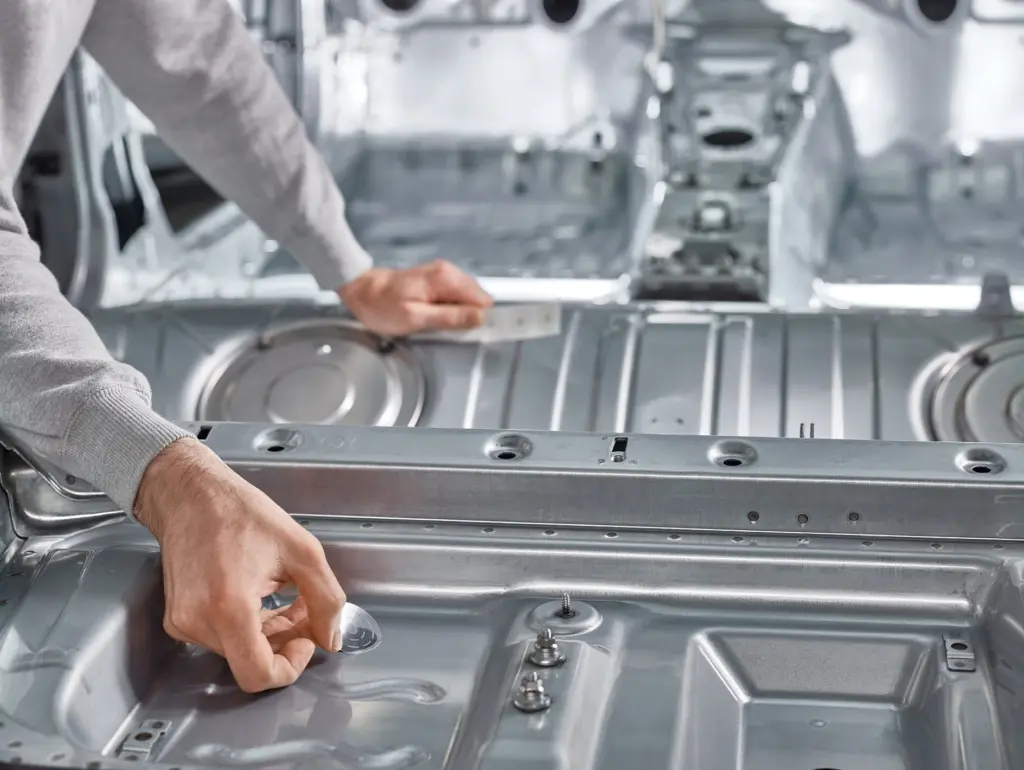
Selection Guide by Application
Exterior Trims and Body Side Moldings
Recommended tape type: Acrylic foam tape (standard or LSE grade depending on substrate)
Key requirements: High peel adhesion after thermal cycling, UV resistance, outdoor weathering durability, stress relaxation for long bond lines, and compatibility with automotive paint or low-surface-energy plastic trims.
Why it works: Acrylic foam tapes distribute stress across the bond area, accommodate differential thermal expansion between metal panels and plastic trims, and maintain adhesion through years of sun, rain, and temperature swings. LSE grades are essential for unpainted polypropylene or TPO moldings.
Intricate Emblems, Nameplates, and Badges
Recommended tape type: Polyurethane foam bonding tape
Key requirements: Die-cutability for complex shapes, high tensile and dynamic shear strength, conformability to curved surfaces, and excellent adhesion to painted finishes.
Why it works: Polyurethane foams are softer and easier to die-cut than acrylic foams, making them ideal for small, intricate parts. They conform to compound curves and provide the shear strength needed to hold emblems against vibration and wash cycles.
Door, Trunk, and Sunroof Seals (Weatherproofing)
Recommended tape type: PVC foam sealing tape or EPDM foam gasket tape
Key requirements: Low compression force, high recovery, closed-cell structure to resist water absorption, FMVSS 302 flammability compliance, and service temperature range covering -26°C to +71°C or wider.
Why it works: These soft, compressible foams create positive seals at mechanically fastened joints, blocking water, dust, and wind noise. Their resilience allows thousands of open-close cycles without taking a permanent set that would compromise the seal.
HVAC Modules and Instrument Panel Sealing
Recommended tape type: PVC foam sealing tape
Key requirements: Conformability to irregular surfaces, low compression force, FMVSS 302 compliance, and peel adhesion strong enough to stay in place during assembly but removable for service.
Why it works: HVAC ducts and housings have complex mating surfaces that need flexible gaskets to direct airflow and prevent condensation leaks. PVC foam tapes compress easily to fill gaps and conform to radius corners.
EV Battery Pack Gaskets and Thermal Management
Recommended tape type: EPDM or PE foam gasket tape (for sealing), thermal interface tape (for heat transfer)
Key requirements: Flame barrier rating (UL 94 V-0 or better), compressibility to accommodate cell breathing, low outgassing, thermal conductivity up to 2 W/m·K for thermal tapes, and solvent/halogen/silicone-free formulation.
Why it works: Battery packs demand multifunctional tapes that seal, cushion, insulate, and manage heat. Compressible foam gaskets accommodate cell expansion without losing sealing performance, while thermal tapes conduct heat from cells to cooling plates more efficiently than greases or pads.
Under-Hood Heat Shields and Insulation
Recommended tape type: High-temperature acrylic foam tape
Key requirements: Continuous service above 100°C, short-term resistance to 150°C+, resistance to automotive fluids (oil, coolant, fuel), and strong adhesion to metals and coated surfaces.
Why it works: Under-hood environments subject tapes to extreme heat and chemical exposure. High-temperature acrylic adhesives maintain bond strength without softening or flowing, and the foam core cushions against vibration from the engine and road.
Conclusion
Automotive sealing tapes have matured into precision-engineered materials that solve problems mechanical fasteners and liquid gaskets can’t touch. They seal out water and noise, bond dissimilar materials without drilling holes, survive decades of temperature cycling and UV exposure, and increasingly take on multifunctional roles in battery packs and electric drivetrains. The difference between a tape that performs and one that fails comes down to understanding what the application demands—substrate compatibility, temperature resistance, mechanical loading, environmental exposure—and matching those requirements to the right foam chemistry, adhesive system, and test data.
For technicians and engineers, the key is to move beyond generic “sealing tape” thinking and dig into the specifications: ASTM test results, OEM material compliance, service temperature windows, and real-world validation. Acrylic foam tapes excel at structural bonding and outdoor durability. Polyurethane foams handle intricate die-cuts and conform to curves. PVC and EPDM foams create soft, compressible seals. Specialty laminates bring flame barriers, thermal conductivity, and electrical insulation to EV battery assemblies.
As vehicles become lighter, more efficient, and more electric, sealing tapes will continue to replace legacy fastening and sealing methods. The materials are proven, the testing protocols are standardized, and the results speak for themselves in millions of vehicles on the road. Choose the right tape for the job, prepare surfaces properly, and follow installation guidelines—and the bond will outlast the parts it’s holding together.
